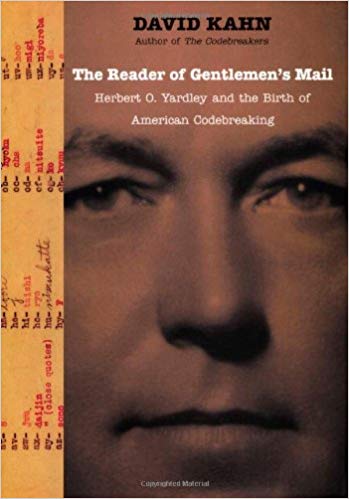

Dr. David Kahn, inducted just two years ago into the National Security Agency’s Hall of Honor, has long held preeminence in the field of cryptology, the study of enciphering and deciphering information. His landmark book, The Codebreakers, published in 1967, followed by decades of research and gathered expertise not only makes him an authority but the best equipped scholar to write this fascinating biography. This book, published in 2004, follows titles including Hitler’s Spies: German Military Intelligence in World War II (1978), Codebreaking in World Wars I and II (1980), Kahn on Codes: Secrets of the New Cryptology (1984), and Seizing the Enigma: The Race to Break the German U-Boats Codes, 1939-1943 (1991), among others. Dr. Kahn even donated his collection of rare documents and materials to the National Cryptological Museum in 2010.
Herbert O. Yardley is not an easy subject about whom to write. He both repels and attracts. His accomplishments are important but not for his talents as a cryptologist. It was Yardley’s talents as a likeable, personable, inspiring administrator that made him shine to then, as a byproduct, illuminate the field of cryptology in public awareness. When it could have — and did — surpass him in both its technical capabilities and the devotion of those who sought to advance it for its potential (thanks to individuals like William Friedman), Yardley’s worst characteristics — his greed, his laziness, his proclivity to bend the truth, his love for pleasure — surfaced and thus hampered what could have been work that achieved far more than it did under his guidance. He could have been greater than he was. He had the talent to masterfully craft a compelling story (The American Black Chamber and The Education of a Poker Player) but he had the talent for self-destructive choices as well. His triumph came early at the deciphering of Japanese code and classifying code types during the Washington Naval Conference in 1922. Earning the Distinguished Service Medal as a result did not make Yardley an unqualified hero but did reveal the tensions existing between American ideals and the nature of espionage as condoned policy. The very work done out of wartime necessity seemed to violate something fundamental about America, leaving its practitioners sullied, guilty, at war even with themselves. Yet, it was proving a resource that other nations were certainly exploiting with or without U.S. involvement.
The continuation of the Cipher Bureau could have, as Dr. Kahn points out, proven its value far more had Yardley played a better hand with what he had available. Had he focused on advancing with cryptology, for instance, instead of pursuing the next paycheck, he could have contributed further to the field. Dr. Kahn, we believe correctly, does not subscribe to the overly optimistic notion that Yardley could have prevented Pearl Harbor. Nor, do we believe, that Secretary Hughes’ success rested on Yardley’s deciphered communications. The timeline and the documentary record do not corroborate such a conclusion, especially since the decryptions were not reaching Hughes and the Japanese delegation had already revised their ratio conditions before Yardley’s solutions even made the rounds. Hughes’ support for military intelligence hardly implicates him in the worst of Yardley’s disclosures which directly led to Secretary Stimson’s closing of the Bureau in 1929 followed by Yardley’s written retaliation in 1931. This no more delegitimizes the extensive work of Hughes and his team at the Washington Conference in 1921-1922 than it can justifiably blame Coolidge’s budget-cutting administration, or deem Kellogg’s State Department complicit by association with any activities used to spy on gentlemen for diplomatic advantage. Neither should it besmirch the standing policy under Cordell Hull’s State Department to distance, if not shut out entirely, HOY (Herbert Osborn Yardley) from the federal government’s later decryption work.
Ultimately, Yardley squandered multiple opportunities to help himself and his department, building instead a reputation of untrustworthiness when he could have grown with the technology and helped his native land more than he did. He was no traitor to his country, but this did not make his enemies entirely blameless in passing dubiously-based legislative reprimands to prevent the publication of a manuscript already in the government’s possession, now known as Public Law 37, the Act for the Protection of Government Records, still on the books since 1933 (Section 952 of Title 18). Dr. Kahn handles the subject and Yardley’s place in cryptology with all the skill of the author’s well-balanced perspective. It is a fascinating read but be advised, readers, it is — like Yardley himself — a meshwork of qualities easy to like and easy to loath. Major Yardley belongs about where Dr. Kahn has estimated his place in history.